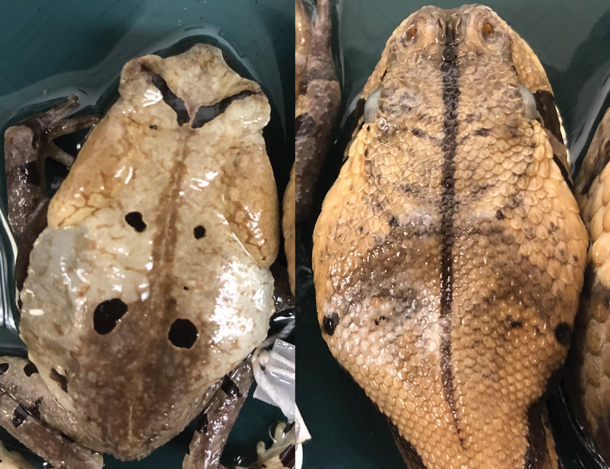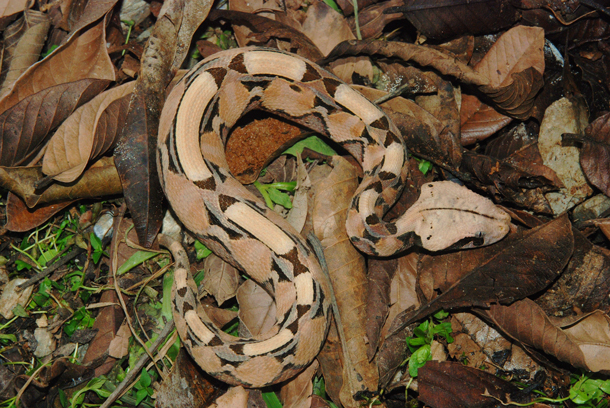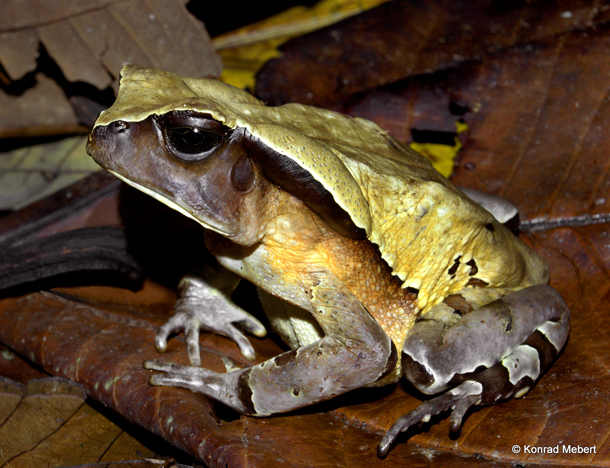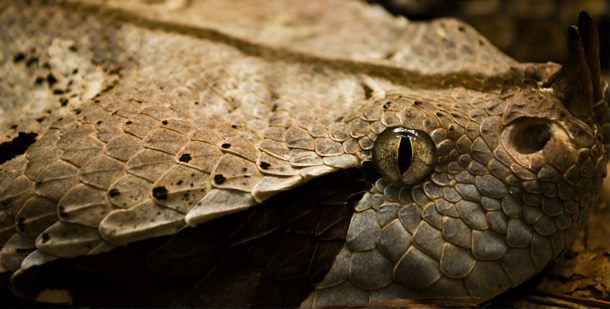Science Note: Toad Mimics Venomous Snake
Air Date: Week of November 29, 2019

Subadult Comparison: A side-by-side comparison between a subadult Congolese giant toad and a subadult Gaboon viper from above, showing similar color pattern, shape and size. (Photo: courtesy of Eli Greenbaum)
If you want to make it, fake it: researchers have discovered that harmless Giant Congolese Toads (Sclerophyrs channingi) mimic the venomous Gaboon vipers (Bitis gabonica) that share their central African rainforest homes. The toads, which are the first toads known to mimic a snake, use a whole toady toolkit, as Living on Earth’s Don Lyman tells us. Their bodies mimic the heads of vipers, and they raise their hindquarters to mimic a viper’s strike pose, even hissing like a snake if anyone gets too close.
Transcript
LYMAN: There are well known examples of harmless animals mimicking deadly snakes. Burrowing owls can make a sound like a rattle snake. Benign snakes, like the
scarlet king snake, mimic the color patterns of venomous snakes, like the coral snake. But now researchers have discovered what they believe to be the first known case of a toad species imitating a venomous snake.

A young Gaboon viper (Bitis gabonica) on the rainforest floor in Democratic Republic of the Congo. (Photo: Colin Tilbury, courtesy of Eli Greenbaum)
Scientists analyzed specimens of giant Congolese toads, and Gaboon vipers, Bitis gabonica, and found that the rear end of the toads looked an awful lot like the heads of the Gaboon viper. Both species evolved together 4 to 5 million years ago in the same Congolese rainforest. The toads also appear to have evolved two behaviors that imitate the Gaboon viper. The toads display a color pattern and shape that resembles the cocked head of a Gaboon viper in a strike position. And, when the toads feel threatened, they make a hissing sound similar to the Gaboon viper's hiss.

An adult Congolese giant toad (Sclerophrys channingi) from Democratic Republic of Congo ( (Photo: Konrad Mebert, courtesy of Eli Greenbaum)
[SFX GABOON VIPER HISS]
LYMAN: Scientists believe this unusual case of mimicry helps protect toads from being eaten by predators, which might be tricked into thinking a harmless toad the size of a fist is a 6 foot long venomous snake. That’s this week’s note on emerging science. I’m Don Lyman.

Giant Congolese Toad? Nope! This is the real thing, the Gaboon Viper (Photo: Tom Conger on Flickr, CC)
Links
More about how the mimicry works
Read the original scientific publication in The Journal of Natural History
Living on Earth wants to hear from you!
Living on Earth
62 Calef Highway, Suite 212
Lee, NH 03861
Telephone: 617-287-4121
E-mail: comments@loe.org
Newsletter [Click here]
Donate to Living on Earth!
Living on Earth is an independent media program and relies entirely on contributions from listeners and institutions supporting public service. Please donate now to preserve an independent environmental voice.
NewsletterLiving on Earth offers a weekly delivery of the show's rundown to your mailbox. Sign up for our newsletter today!
 Sailors For The Sea: Be the change you want to sea.
Sailors For The Sea: Be the change you want to sea.
 The Grantham Foundation for the Protection of the Environment: Committed to protecting and improving the health of the global environment.
The Grantham Foundation for the Protection of the Environment: Committed to protecting and improving the health of the global environment.
 Contribute to Living on Earth and receive, as our gift to you, an archival print of one of Mark Seth Lender's extraordinary wildlife photographs. Follow the link to see Mark's current collection of photographs.
Contribute to Living on Earth and receive, as our gift to you, an archival print of one of Mark Seth Lender's extraordinary wildlife photographs. Follow the link to see Mark's current collection of photographs.
 Buy a signed copy of Mark Seth Lender's book Smeagull the Seagull & support Living on Earth
Buy a signed copy of Mark Seth Lender's book Smeagull the Seagull & support Living on Earth

